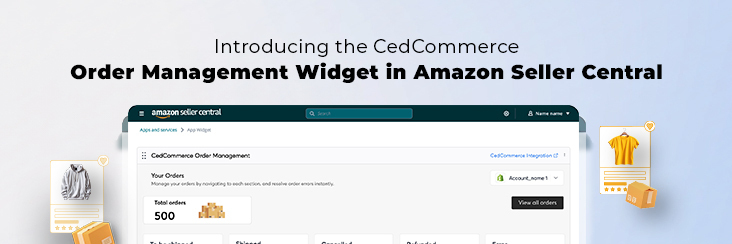Walmart Embraces Amazon MCF: A New Era of Cross-Platform Fulfillment for eCommerce
Walmart Embraces Amazon MCF: A New Era of Cross-Platform Fulfillment for eCommerce
eBay holds a prominent place as a renowned online marketplace. It presents an option to sell a wide array of products to a diverse range of sellers. As a result, in this bustling digital marketplace, having a well defined return policy isn’t just a good idea; it’s a crucial component.
Understanding eBay’s return policies, such as the 30 day return policy, the 14 days window, and the rare “no return” scenarios, can significantly impact your selling experience. Join us as we delve into the ins and outs of eBay’s return policies. We’ll explore how they shape the dynamic eCommerce landscape in the marketplace and how to create an eBay Return Policy that aligns best with your business.
eBay’s return policy is a part of the well designed eBay business policies system that offers various options catering to sellers and buyers. Sellers have the flexibility to choose from multiple return options, including ‘No returns accepted.’ Although eBay highly recommends opting for more buyer friendly choices, such as eBay’s return policy in 14 days, 30 days, or 60 business days. Moreover, sellers can opt for free returns, potentially increasing sales by a significant margin—anywhere from 5% to 25%.
From the buyer’s perspective, eBay aims to provide a hassle-free shopping experience. This means that once you start offering more lenient return options like “eBay 30 days return policy,” you may experience a noticeable boost in sales.
When buyers initiate return requests, the eBay return policy allows sellers to establish rules for quick returns and refunds for the buyer. eBay’s Return Policy emphasizes the importance of balancing seller and buyer convenience.
Initiating returns on eBay involves a collaborative effort between buyers and sellers. It promotes transparent communication. When selling on eBay, you need to outline your stance on returns, specifying conditions under which they’re allowed. These conditions cover aspects like return shipping responsibility and the timeframe for accepting returns post-sale.
Creating a well defined return policy is crucial. Addressing return requests instantly enhances the shopping experience, offering efficient resolutions. For sellers accepting returns, automated rules can streamline return request management. eBay’s return policy for sellers serves various purposes, including:
The eBay Money Back Guarantee provides comprehensive coverage for a wide array of eBay transactions, ensuring buyers have recourse in case issues arise. This policy safeguards buyers’ interests, permitting them to seek a refund if the received item doesn’t meet the outlined criteria.
Here’s a concise breakdown of the eBay Money Back Guarantee, covering its scope, eligibility conditions, and crucial exclusions.
The eBay Money Back Guarantee is applicable in the following circumstances:
Sellers involved in transactions covered by the eBay Money Back Guarantee umbrella:
In cases where sellers offer international shipping or don’t exclude international options:
When a buyer reports non-delivery and meets eligibility criteria, eBay investigates by considering the following:
To establish on-time delivery, eBay requires the following:
For local pickup items, proof of collection includes:
Effective return request management is essential for a successful eBay selling experience. You can establish automated rules for return acceptance or instant refunds to optimize this process and save time. When listing items, you must indicate your return policy and conditions, covering aspects like return shipping costs and the timeframe for requested returns on eBay. But clarity is key; ensure your eBay return policy is well stated in your listings.
Sellers embracing returns can utilize eBay’s automated rules to streamline the process. These rules enable you to:
Automation boosts efficiency and provides excellent customer service by promptly addressing buyer return requests.
eBay provides diverse return policy options catering to different preferences:
Certain product categories may have unique return policies, with some allowing a 14 day return policy:
Here’s a step by step guide to setting up your eBay returns:
For tailored automation, eBay allows the creation of advanced return rules:
The realm of online marketplaces occasionally gives rise to misconceptions, and eBay is not immune to this. Let’s clarify common misconceptions about eBay returns and provide facts.
Clarification: A notable misconception is the assumption that eBay imposes a standardized, one size fits all return policy for all sellers. Every eBay seller enjoys the autonomy to define their unique return terms. This translates to varying return policies across sellers. Sellers can opt to accept returns, set return timeframes, stipulate return shipping responsibility, and establish relevant conditions. Therefore, the outcome is a spectrum of return policies that align with varied seller preferences and business models.
Clarification: Sellers can craft distinct return policies contingent on the item categories listed. This permits nuanced returns management. For instance, sellers can set extended return windows or specific terms for electronics, fashion, or collectables. eBay’s platform accommodates these policy variations to suit the diverse products offered.
Clarification: While eBay equips sellers with tools and guidelines for seamless returns, the returns management rests with individual sellers. The sellers’ responsibilities are initiating refunds, processing returns, and addressing issues. eBay’s role centers on providing a platform conducive to these processes, fostering a transparent and efficient marketplace.
In the dynamic world of eBay transactions, two key things make all the difference: talking things out effectively and making buyers happy. Unlike elsewhere, eBay doesn’t force everyone to follow the same return rules. That means you can create rules that match what you sell and how you do things.
Every seller’s return policy shows how serious they are about giving top notch service while recognizing the different stuff they sell. Sellers can improve things by being clear about their return rules and using automatic tools to handle certain parts of the return process. Above all, blending clear rules with clever automation moves is like making a masterpiece.

Walmart Embraces Amazon MCF: A New Era of Cross-Platform Fulfillment for eCommerce

Order Management Redefined: A Centralized Solution for Amazon Sellers

Maximizing TikTok Shop’s Regional Compatibility for US, UK, and EU Markets

Understanding U.S. Tariffs in 2025: What Sellers Need to Know and Do

Walmart’s Search Algorithm Decoded: How to Rank Higher & Sell More

TikTok Gets a 75-Day Reprieve in the USA as Trump Signals Hope for a Deal

TikTok Shop Introduces Category-Based Benchmarks for Product Listings – What Sellers Need to Know

Amazon FBA vs. FBM: Which Fulfillment Method Is Right for You?

Amazon Launches Another AI Tool for Sellers: AI Generated Product Enrichment

Top 10 Selling Items on eBay in 2025

Amazon launches AI Powered ‘Interests’ Feature to Improve Shopping Experience

Is TikTok Staying in the US? The State of TikTok Ban

Best Buy coming back to the US, Marketplace Relaunch and New Opportunities in Store!

Miravia PrestaShop Connector: Built for Smart Sellers

Walmart Launches “Wally”, AI Assistant For Merchants

TikTok Shop to Start Business in Germany, France, and Italy

TikTok Shop Surges as Americans Spend $700 Annually, Defying Regulatory Pressures

Amazon’s Longest Prime Day Ever: What You Need to Know

eCommerce Growth in the Netherlands: A 5% Surge in 2024 with Bright Prospects Ahead

CedCommerce Launches Shopee & Lazada Integration for WooCommerce on WordPress.com